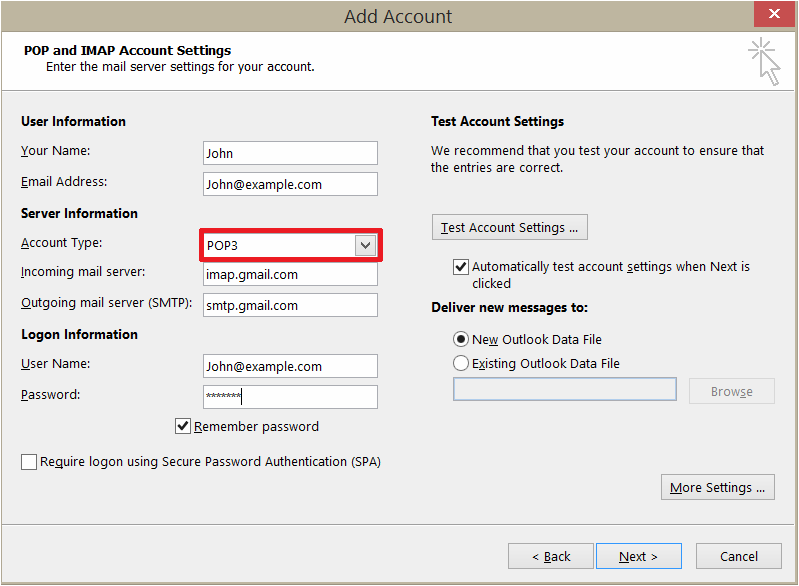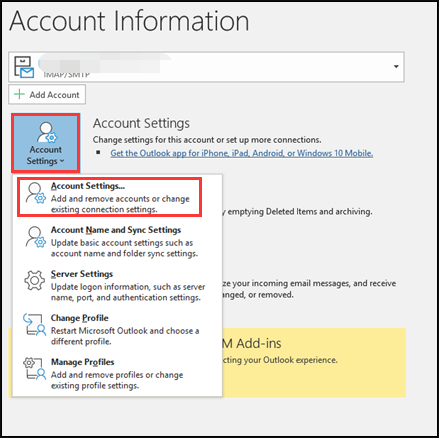

- #TDS EMAIL SETUP FOR OUTLOOK WINDOWS 10 HOW TO#
- #TDS EMAIL SETUP FOR OUTLOOK WINDOWS 10 INSTALL#
Finally, right-click ZeroConfigExchange, click Modify and then in the Value data box, type 1, and then click OK. Once the key is created, right-click in the right pane and click New, click DWORD Value and type in “ZeroConfigExchange” (without the quotes) and then press ENTER.ģ.
As a policy: HKEY_CURRENT_USER\Software\Policies\Microsoft\Office\14.0\Outlook\AutoDiscoverĢ. For Outlook 2010: HKEY_CURRENT_USER\Software\Microsoft\Office\14.0\Outlook\AutoDiscover. As a policy: HKEY_CURRENT_USER\Software\Policies\Microsoft\Office\15.0\Outlook\AutoDiscover. For Outlook 2013: HKEY_CURRENT_USER\Software\Microsoft\Office\15.0\Outlook\AutoDiscover. As a policy: HKEY_CURRENT_USER\Software\Policies\Microsoft\Office\16.0\Outlook\AutoDiscover. For Outlook 2016: HKEY_CURRENT_USER\Software\Microsoft\Office\16.0\Outlook\AutoDiscover. In the Windows Registry, navigate to the appropriate subkey for each version of Outlook that is in use: It can be added (through a login script) to the user's registry or as a group policy setting for all users. However, the underlying mechanism used to gather configuration data for your connection to Exchange is Autodiscover. Again, ZCE is used as a way to automatically configure an Outlook profile for one or many users with Exchange Online or Exchange on-premises accounts. It's important to note that there are no supported tools for modifying an Exchange Online account. ZCE is a registry setting that tells Outlook to create a new profile using the SMTP address from Active Directory and to then leverage Autodiscover. only data that every user should already know (account name and/or password). That is, the user does not have to enter any configuration data. ZeroConfigExchange (ZCE) can be used to create new profiles for users with minimal user interaction. So, how can we automate the Outlook profile creation? While you can still use a PRF for your on-premises environments and Outlook 2013 or earlier versions, it is recommended that you use Autodiscover, which is supported for creating Outlook profiles in both on-premises and Exchange Online environments. Using Autodiscover, Outlook finds a new connection point made up of the user's mailbox GUID + + the domain portion of the user's primary SMTP address. PRF files to configure Exchange accounts in Outlook 2016. Outlook clients no longer connect to a server fully qualified domain name (FQDN) as they've done in all previous versions of Exchange. Outlook 2016 - changes to how Exchange Autodiscover information is stored in parallel with an Outlook profile prevents the use of. This is normally acceptable for on-premises environments using Exchange 2010 and previous versions, but for Exchange 2013 and greater, along with for Exchange Online accounts, the server name contains a variable GUID that can change from time to time and from user to user. PRF file requires an Exchange server name to be hard-coded. However, there are two scenarios under which the use of. Typically, an Outlook profile (.prf) file, which is generated through the Office Customization Tool (OCT), can be used for most situations. #TDS EMAIL SETUP FOR OUTLOOK WINDOWS 10 INSTALL#
Click Close to finish off the install and Click Finish on the next screen also.Often we are asked if we can automate the creation or modification of new Outlook profiles, en-masse, for Exchange accounts. If everything tests correctly, you should get a Completed status. My preference is to leave it on the server until I delete it, hence the settings below.īack on the Main Account menu, Click Next to test the install and finish things off. POP3 downloads the email from the server, and you have the option to delete the email once you do this or leave it on the server. Note, POP3 is not like IMAP, where it keeps your mailbox in sync with the server. Outgoing Server (SMTP) – Port 587 and Enable TLS with Dropdown.Incoming server (POP3) – Port 995 and Enable SSL with Check Box.Next, click the Advanced Tab and use the following Settings for the Server Ports and Delivery. Once all the information is filled out, Click More SettingsĬlick the Outgoing Server Tab and check the box to enable authentication for the SMTP server. Using Outlook 2010, Click File, Info, Account Settings.Ĭhoose the “Manually Configure Server” bullet and click Next.Ĭlick the Internet E-mail bullet and click Next again.Įnter your name, email, and various account info as shown below.
#TDS EMAIL SETUP FOR OUTLOOK WINDOWS 10 HOW TO#
How To Add an to Outlook 2010 or Outlook 2007 using POP3 and SMTP

You should use EAS as it configures everything automatically. If you’re using Outlook 2013, you should not use POP3. All my screenshots are taken using Outlook 2010 however, 2007 should be very similar. For this tutorial, however, let’s focus only on how to get your email client working using POP3 and SMTP.






 0 kommentar(er)
0 kommentar(er)
